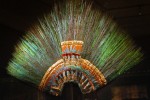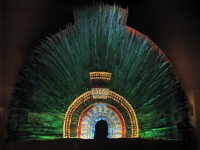 Moctezuma’s headdress is a large and elaborate 16th century crown which according to legend once belonged to Aztec emperor Moctezuma II, made from the iridescent green tail feathers of the Resplendent Quetzal. Moctezuma either gave it to Hernán Cortés as a gift upon his arrival at Tenochtitlan, the capital of the Aztec empire and modern day Mexico City, or it was pillaged by Cortés’ forces after the siege of Tenochtitlan in 1521.
Moctezuma’s headdress is a large and elaborate 16th century crown which according to legend once belonged to Aztec emperor Moctezuma II, made from the iridescent green tail feathers of the Resplendent Quetzal. Moctezuma either gave it to Hernán Cortés as a gift upon his arrival at Tenochtitlan, the capital of the Aztec empire and modern day Mexico City, or it was pillaged by Cortés’ forces after the siege of Tenochtitlan in 1521.
There is no record of where it was taken, nor is there any evidence that it belonged to Moctezuma. We don’t even know for sure that it’s a headdress. It doesn’t match any of the headdresses depicted in contemporary accounts. In the 19th century the assumption was that it was a mantle, and recent scholarship suggests they might have been right about it being a mantle, but that it was worn by a priest to ritually transform him into the incarnation of the Aztec god Quetzalcoatl, rather than by the king.
What we do know is that by 1575 it was in the extensive private collection of Ferdinand II, Archduke of Austria, at Ambras Castle in Innsbruck. Ferdinand was the nephew of Holy Roman Emperor Charles V who was also King of Spain during the Conquista. He could easily have gotten his hands on the headdress via his family connections.
It remained in the castle until the early 19th century when Vienna’s Museum of Ethnology was entrusted with most of the Castle Ambras collection. The headdress was the subject of much anthropological fascination from then on, including from Zelia Nuttall, the American archaeologist, anthropologist and expert in pre-Columbian Mexico who in 1890 first identified it as an Aztec “quetzalapanecayotl” or a featherwork crown.
 The piece is 46 inches high at the peak and 69 inches wide. In addition to the 400 dramatic quetzal tail feathers that adorn the outer layer, there are rows of blue Lovely Cotinga feathers, pink flamingo feathers, smaller quetzal feathers and white and red feathers from the squirrel cuckoo. The inner rings are studded with gold and gemstones. The Aztecs venerated the Resplendent Quetzal as the god of the air, a symbol of rebirth and of freedom.
The piece is 46 inches high at the peak and 69 inches wide. In addition to the 400 dramatic quetzal tail feathers that adorn the outer layer, there are rows of blue Lovely Cotinga feathers, pink flamingo feathers, smaller quetzal feathers and white and red feathers from the squirrel cuckoo. The inner rings are studded with gold and gemstones. The Aztecs venerated the Resplendent Quetzal as the god of the air, a symbol of rebirth and of freedom.
Given its beauty, historical significance and powerful symbolism, it’s no surprise that the headdress has been the subject of a long-standing dispute between Mexico and Austria.  There are no Aztec headdresses left in Mexico because the Spanish took them all — the Museo Nacional de Antropología in Mexico City only has a replica of Moctezuma’s headdress on display — so Mexico has been trying for decades to get this one back, even going so far as to petition the United Nations for its return, but to no avail.
There are no Aztec headdresses left in Mexico because the Spanish took them all — the Museo Nacional de Antropología in Mexico City only has a replica of Moctezuma’s headdress on display — so Mexico has been trying for decades to get this one back, even going so far as to petition the United Nations for its return, but to no avail.
In 2008, the Mexican Ministry of Foreign Affairs and the National Institute of Anthropology and History (INAH) entered into talks with the Austrian Government and the Kunsthistorisches Museum, the parent institution of the Museum of Ethnology. They agreed first to do an extensive scientific analysis on the headdress to assess its condition and do any conservation necessary that will allow the piece to travel. In 2011, a tentative deal was struck: Mexico would officially recognize Austria’s uncontested ownership of the headdress, Austria would loan Mexico the headdress and in return Mexico would loan Austria the golden stagecoach of Maximilian I of Mexico, emperor of the Second Mexican Empire (1863-1867) and brother of Emperor Franz Joseph I of Austria.
There was still one major stumbling block, however. According to Mexican law, all pre-Columbian artifacts belong to the nation. Once they cross the border, no matter who else might lay claim to them, they become property of the state and cannot leave the country. No matter the terms of the loan agreement, Austria had no intention of letting the headdress into Mexico until the government’s assurances had the force of law.
A new bilateral cultural exchange agreement between Austria and Mexico that would resolve the issue has just been approved by the Mexican Senate and Austria’s cabinet. The Senate’s amendments to the cultural property law allow for long-term loans of artifacts while acknowledging the lender’s ownership rights. Austria’s legislature has to approve the deal, which is expected to happen within the next few months, and both parties need to sort out how to transport the fragile headdress without damaging it, but it looks like the biggest obstacle to the return of this glorious symbol of Mexican heritage might just have been overcome.